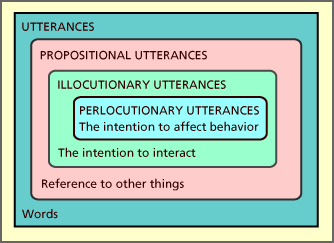Dr. Jacobsen
| Constatives--“Statements, assertions, and utterances” characterized by truth or falseness. |
| Performatives--Statements, assertions, and
utterances
that do things. The table below abstracts the performative
categories.
|
|
Category
|
Action
|
Example
|
|
Representatives
|
Tell
how things are
|
Concluding
|
|
Directives
|
Encourage
action
|
Requesting
|
|
Commissives
|
Commit
speaker to action
|
Promising
|
|
Expressives
|
Express
psychological state
|
Thanking
|
|
Declarations
|
Change
the state of affairs
|
Christening
|
For performatives to actually "perform," both speaker and audience must accept certain assumptions about the speech act. These assumptions are called felicity conditions and are often divided into three categories: essential conditions, sincerity conditions, and preparatory conditions.
- Essential condition--This means that you say what you say, that both speaker and hearer take the utterance to be performative. EX: If you say "I promise to do my homework" to a teacher, both of you think of that statement as taking the form of a promise. If you quote yourself to a friend as saying "I told my teacher 'I promise to do my homework,'" the quote--though identical in its locutionary properties (see below)--fails to promise because it has become part of a representative act reporting on the promise.
- Sincerity condition--This means that you mean what you say, that both speaker and hearer take the utterance to be intentional, to accurately represent the wish of the speaker and the hearer's understanding that the utterance expresses that wish. The common expression "in good faith" illustrates the basic premise of the sincerity condition. EX: If you say "I promise to do my homework" to a teacher, both of you think of that statement as being a promise, as a verbal contract suggesting that you want to do the homework and possess the requisite capacities to complete it.
- Preparatory conditions--This means that you can do what you say, that both speaker and hearer agree that it is situationally appropriate to for you to perform the speech act. Don't confuse "can do" with "able to do." Ability is part of sincerity. In this case, "can do" means "allowed to do," to be socially sanctioned to perform the act. EX: If you say "I promise to do my homework" to a teacher, you are actually a student in the teacher's class and the homework has been assigned. If these conditions were not met, you'd have no homework and, thus, no need to promise to do it.
Types of Force
There are three types of force typically cited in Speech Act Theory:
- Locutionary force—referential value (meaning of code)
- Illocutionary force—performative function (implication of speaker)
- Perlocutionary force—perceived effect (inference by addressee)
Let's again use our example of the promise. If you say "I promise to do my homework" to a teacher, the locutionary force lies in the meaning of the words "I promise to do my homework" (just as it does in the quotation of the promise to the friend: their grammatical and semantic content is identical). The illocutionary force lies in your intent to make a promise; the perlocutionary force lies in the teacher's acceptance that a promise was made. In a sentence, you have said "I promise to do my homework" (locution), you want your teacher to believe you (illocution), and she does (perlocution).
The graphic below illustates the relationship of the forces.
 |
| Sources: Searle, “A Classification of Speech
Acts” Language
in Society
Searle, “Indirect Speech Acts”Book Chapter Image Source TUTORIAL: INTERACTION AND RELATIONSHIPS <http://www.rdillman.com/HFCL/TUTOR/Relation/relate2.html> |